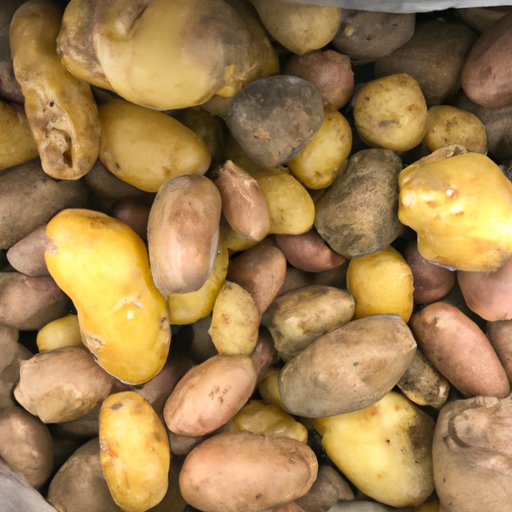
I. Introduction
As a staple in many dishes, potatoes are a common ingredient found in most kitchens. However, if you’re not careful, potatoes can go bad, and consuming bad potatoes can lead to food poisoning. That’s why it’s essential to know how to tell if potatoes are bad and when to throw them out. This article will go over everything from identifying the signs of bad potatoes to proper storage and cooking tips.
II. Symptoms of Bad Potatoes
One way to determine if potatoes have gone bad is by visually inspecting them. Bad potatoes typically have discolored or soft spots, sprouting, or a shriveled texture. These symptoms could indicate bacterial infection, mold, or fungus growth. If you notice any of these signs, it’s crucial to remove the affected potatoes to avoid spreading the spoilage to the rest of the batch.
Examples of bad potatoes include ones that are green, slimy, or have black spots. Green potatoes signify the presence of solanine, a compound that occurs when potatoes are exposed to too much light. Consuming solanine can lead to a variety of symptoms such as vomiting, headaches, and stomach cramps. On the other hand, slimy or black potatoes indicate bacterial growth, which can cause food poisoning.
III. Smell
Another way to tell if potatoes are bad is by using your sense of smell. If a potato has a musty or moldy odor, it could be a sign that it’s gone bad. Potatoes that are stored in warm or humid environments are more prone to developing a musty smell. In contrast, potatoes stored in a refrigerator can develop a sweet smell because the starches convert into sugar at low temperatures.
It’s crucial to use your sense of smell when determining potato freshness because it can help identify potatoes that may appear okay but are still bad on the inside.
IV. Proper Storage
Proper storage is key to keeping potatoes fresh for an extended period. The shelf life of potatoes varies depending on the type. Potatoes stored at room temperature typically last for two weeks. In contrast, potatoes stored in a root cellar or cool, dark place can last up to several months.
When storing potatoes, it’s best to use a breathable container such as a wicker basket or paper bag. Plastic bags trap moisture, which can hasten spoiling. Potatoes should be kept in a cool, dark place away from light sources, such as a pantry or cellar. Avoid storing potatoes near other ethylene-producing fruits and vegetables, such as apples and onions, as they can speed up the ripening process.
V. Cooking with Bad Potatoes
Using bad potatoes in recipes can affect the taste and texture of your dishes. Discolored or soft potatoes can turn mushy or gritty when cooked. However, mildly bad potatoes can still be salvaged by cooking them differently. For example, you can puree bad potatoes and use them as a base for soups or stews, or mash them with butter and cream to make potato cakes or gnocchi.
VI. Varieties of Potatoes
Not all potatoes are created equal, and some varieties are more prone to spoiling than others. For example, russet potatoes have a longer shelf life than new potatoes. Additionally, potatoes with thicker skins are less susceptible to spoilage. To identify if a specific variety has gone bad, pay attention to the symptoms and smells listed earlier in the article.
VII. Health Risks
Consuming spoiled potatoes can lead to food poisoning, which can cause nausea, vomiting, diarrhea, and fever. In severe cases, it can even lead to death. It’s crucial to avoid eating bad potatoes and dispose of them immediately to prevent any health risks.
If you suspect that you’ve eaten spoiled potatoes, monitor your symptoms and seek medical attention if they persist or worsen.
VIII. Conclusion
In conclusion, knowing how to identify bad potatoes is crucial to maintaining food safety and avoiding illness. Symptoms of bad potatoes include discolored or soft spots, sprouting, or a shriveling texture. You can also use your sense of smell to determine freshness. To prevent spoilage, store potatoes in a cool, dark place and avoid storing them near other fruits and vegetables that produce ethylene. Finally, if you’re unsure if a potato is bad, it’s always better to err on the side of caution and dispose of it.




